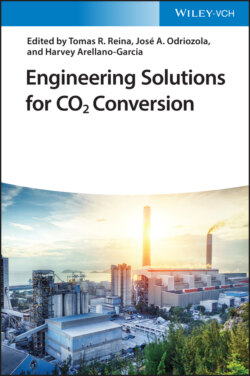Читать книгу Engineering Solutions for CO2 Conversion - Группа авторов - Страница 47
3.3.3 Existing Developments
ОглавлениеCurrently, the R&D efforts are mainly focused on the development of new materials and membrane architectures with better performance and stability, as well on the search of new applications. All these developments are being carried out at laboratory scale; nevertheless, there are companies and institutions that are advancing in the upscaling of OTM concepts, with significant progresses in integrating ceramic membrane modules in industrial environments. Among all, the most advanced progresses have been achieved by Praxair and Air Products [56, 57], with the construction of demonstrative plants with OTM technology at high Technology Readiness Levels (TRL). These companies have worked for more than 20 years in the development of industrial‐scale OTM modules and integrated gasification combined cycle (IGCC) systems with ceramic membranes for O2 separation.
Figure 3.5 Simplified process layouts for oxygen permeating membrane modules integrated in oxyfuel power plants following (a) 4‐end and (b) 3‐end mode approaches, (c) Air Products' planar stacks, and (d) combined system steam reformer‐OTM‐ATR developed by Praxair.
Source: Linde.
With regard to Air Products, the most advanced developments consisted of an intermediate scale testing with a capacity of 100 temperature programme desorption (TPD) O2 (corresponding to an IGCC output of 12 MW) [58] and a membrane vessel consisting of several 1 TPD O2 OTM modules (as those shown in Figure 3.5c), with a total production of 2000 TPD O2. Despite that Air Products developments are the most advanced in terms of integration and demonstration, performance, and TRLs, they have been apparently abandoned since 2015 because of a company structure reorganization.
Praxair's developments present a tubular geometry where OTM tubes and CH4 reforming tubes are combined in systems for oxy‐combustion and syngas production applications by using advanced boilers and heaters in combustion processes [59–61]. As it can be observed in Figure 3.5d, Praxair's OTM concept consists of a multi‐panel tubular reactor system where natural gas steam reforming, O2 separation, and autothermal reforming is carried out by using integrated U‐shaped reformer and OTM tubes.
Research centers such as RWTH‐Aachen and the Fraunhofer Institute for Ceramics Technologies and Systems (IKTS) – both located in Germany – are conducting other of the most advanced developments in the OTM field. RWTH‐Aachen designed, fabricated, and tested in a realistic environment an OTM module within the OXYCOAL‐AC Project [62, 63]. The main aim of this development was to demonstrate a zero‐CO2 emission proof of concept for coal‐fired power plants using an OTM module as an O2 supply unit for conducting and oxy‐combustion [64]. For that, an OTM module was developed consisting of BSCF tubular membranes (15 m2 membrane area with 570 tubes) with a production capability of 0.6 TPD O2, generating up to 120 kW by combusting pulverized coal. With regard to IKTS, which are specialized in the manufacturing and testing of 3‐end OTM module systems considering BSCF tubes, they constructed the first stand‐alone O2 production unit in 2009 producing 2.7 l min−1 O2 at 850 °C [65], being later improved achieving up to 2 kg O2 h−1 (23.3 l min−1).
